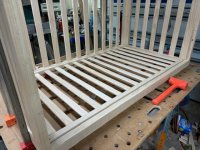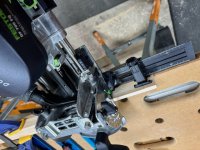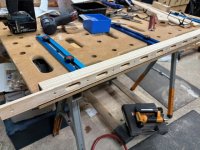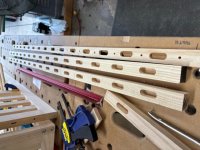Mike Goetzke
Member
- Joined
- Jul 12, 2008
- Messages
- 1,133
I’m making a crib and had an idea to use the new WP half-round metric bits to make the slats the tenons instead of mortising a smaller Domino into the end of the slats. I made a jig that attached to the rails with pin nails and plunged the mortises with one trim-stop setting and then the second. Ha - I’m getting old so have to work smarter so made trials on scrap to make sure this would work. I was afraid making two mortises by hand using pencil marks would not be accurate. This worked out well!
[attachimg=1]
[attachimg=2]
[attachimg=3]
[attachimg=4]
[attachimg=1]
[attachimg=2]
[attachimg=3]
[attachimg=4]






